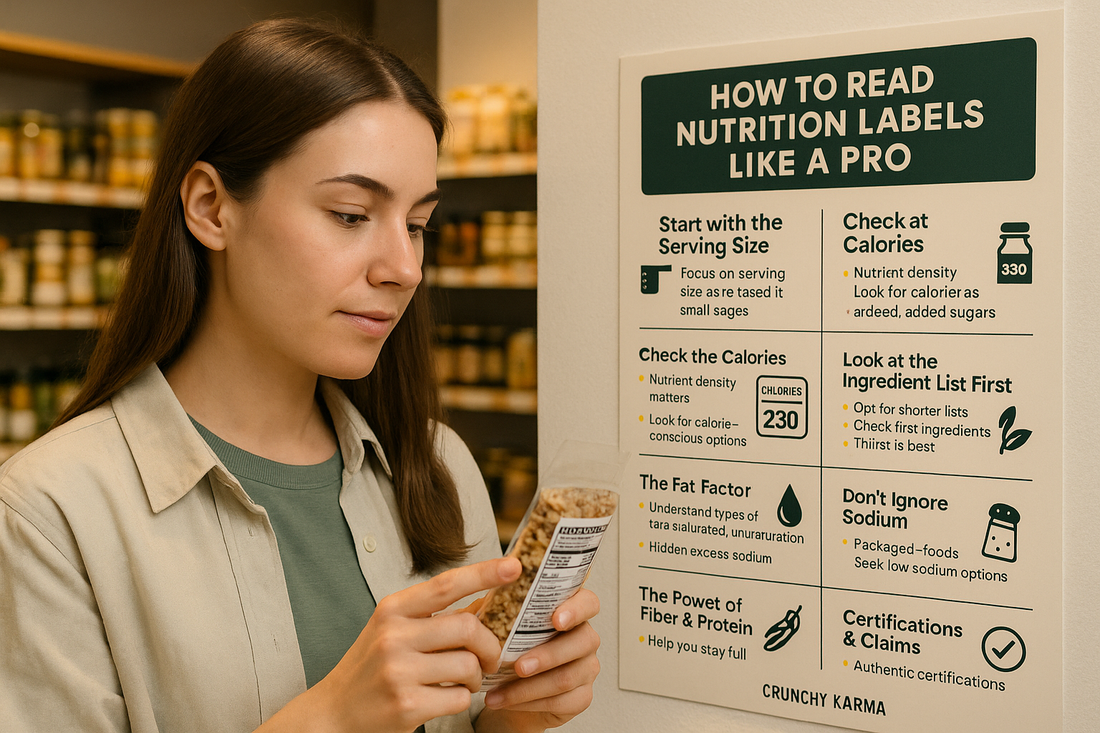
How to Read Nutrition Labels Like a Pro (and Finally Know What You’re Eating)
Sumit YadavShare
How to Read Nutrition Labels Like a Pro (and Finally Know What You’re Eating)
Ever grabbed a packet that screamed “Healthy!” on the front… only to flip it over and feel betrayed by the sugar, salt, and chemicals hiding inside?
You’re not alone.
At Crunchy Karma, we believe the real truth about food isn’t on the front of the pack — it’s on the back, in the nutrition label.
In this blog, we’ll break down exactly how to read nutrition labels like a pro, so you can make better food choices and avoid falling for marketing tricks.
1. Start with the Serving Size
Every number on the label — calories, protein, sugar — is based on one serving.
And here’s the trick: serving sizes can be tiny.
For example:
-
A bag of chips may say 100 calories — but that’s per 25g, while the whole bag is 75g.
-
That means you’re actually eating 300 calories.
✅ At Crunchy Karma, we keep serving sizes realistic so you know exactly what you’re getting.
2. Calories: Quality Over Quantity
Calories are important, but they’re not the full story.
100 calories from almonds will fuel your body differently than 100 calories from soda.
Look for snacks that provide:
-
Moderate calories
-
Nutrient-dense ingredients
-
Energy that lasts longer
💡 Crunchy Karma snacks are calorie-conscious but packed with nutrition.
3. Sugar: The Sweet Trap
Sugar hides in plain sight — sometimes under names like maltose, dextrose, corn syrup, high fructose syrup.
Also, learn to spot the difference between:
-
Natural sugars (from fruits, honey, jaggery) – okay in moderation
-
Added refined sugars – best avoided
🍯 At Crunchy Karma, we use natural sweeteners like jaggery and honey — never refined white sugar.
4. Ingredients First, Always
The ingredient list is more important than the calorie count.
Here’s the rule: The first ingredient is what the product has the most of.
Example:
-
If the first ingredient is whole grain oats, that’s a good sign.
-
If it’s sugar or refined flour, think twice.
🥜 Crunchy Karma snacks start with wholesome bases — nuts, seeds, whole grains — not fillers.
5. The Fat Factor
Not all fats are bad. In fact, your body needs healthy fats.
-
Good fats: nuts, seeds, cold-pressed oils
-
Bad fats: trans fats, hydrogenated oils
🚫 Crunchy Karma never uses trans fats — only natural, healthy fats your body can use.
6. Sodium: The Silent Culprit
Too much sodium can lead to bloating and long-term health risks.
Check the label for milligrams (mg) per serving.
A good rule: less than 150mg per serving for snacks.
🥗 Crunchy Karma snacks keep sodium levels low, without compromising on taste.
7. Fiber & Protein: The Fullness Formula
Fiber and protein are your stay-full allies.
They help:
-
Keep hunger away
-
Stabilize blood sugar
-
Boost metabolism
💪 Many Crunchy Karma snacks are high in fiber and protein, so you feel satisfied for hours.
8. Trust the Certifications
When a product claims to be organic, gluten-free, or high protein, check for authentic certifications like:
-
FSSAI
-
Organic India
-
Gluten-Free Certification
📜 Crunchy Karma proudly displays all our certifications — because we believe in transparent nutrition.
Final Bite 🍏
Reading nutrition labels might feel tricky at first, but once you master it, you’ll never be fooled by flashy packaging again.
Look for simple ingredients, balanced nutrients, and honest brands.
If you’re ready to snack smarter without overthinking, check out our range of Crunchy Karma healthy snacks — where the back of the pack is just as good as the front.
